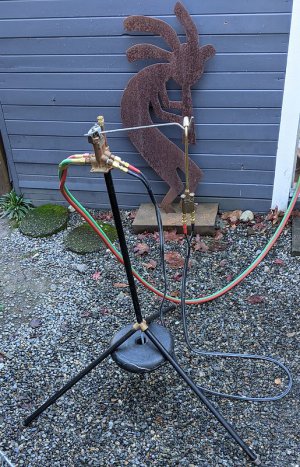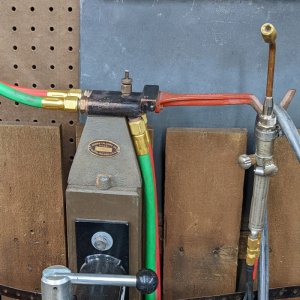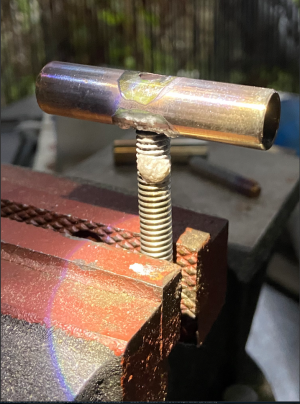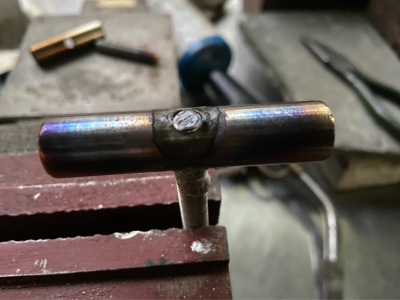Question- as I work I need to re-set and piddle around so I close acet and oxy valves on the torch to save gas and then re-light when ready to resume. Is this what everyone does? Or am I living on borrowed time already?
I love my "gas miser" aka gas saver or gasaver, which is a switch you hang the torch on. The weight of the torch pulls the lever down, shutting off both lines to the torch, but it leaves the torch valves open
and perfectly adjusted. It also supplies a small "pilot light", a little air-acetylene flame that's there ready to light your torch when you pick it back up. Saves a lot of time re-lighting and readjusting the flame, perfect for repetitive work where you have to set up a part, braze it, and turn the flame off while you set up the mext one.
I actually have two of them, total luxury for a home hobbyist, but I grew to like them when I used them in production, so I had to have them for my home shop. I have one each on my acetylene rig and my propane rig.
If this sounds sketchy to you, safety-wise, well I guess it has its potential catastrophe waiting to strike, but in the 50 years I've been using one I don't remember a single scare. You just have to remember to turn everything off before you walk away. The pilot flame is there to remind you, which helps.
The two I have are
(1) a Smith, like this:

Still made, I think, though this one is from the '70s
...and (2), a really old "Harris Calorific", don't know how old but it appears in the 1929 catalog, and may have already been an old item at that time.

Since I mostly work on small stuff, I like the small aircraft torches like the Smith AW1A (well mine is actually an AW1, the precursor to the AW1A) and Meco Midget. As you can see I also like the
Ultralight hoses from Tin Man Tech. The small torch and ultralight hose increases dexterity and precision, decreases fatigue. I don't braze all day like I used to, but I'm old and weak now.

I can't hardly stand the weight and stiffness of those "red/green" welding hoses anymore, I'm spoiled. If you get ultralight hoses though, try to suspend them from the ceiling so they come down to you, not laying on the floor, because they don't hold up to being walked on, or having blobs of molten metal fall on them. Most people daisy-chain them with heavier hose so only the last bit to the torch is ultralight.
But I digress! If you get a gas-saver and you use propane, be aware they make a pilot light specific to propane. The flame tends to blow out if you use propane with the fitting made for acetylene. It's a 2-minute job to switch the pilot light piece. I switch mine back and forth sometimes, though I mostly stick with propane these days.





